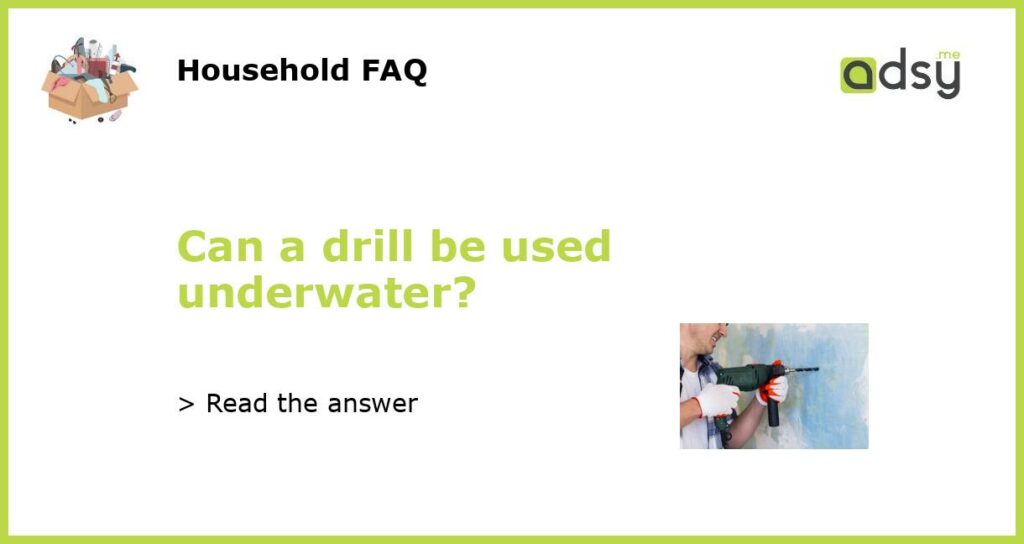Yes, a drill can be used underwater
Underwater drilling is a specialized technique that requires specific equipment designed to operate in submerged conditions. These drills are commonly used in various industries such as offshore oil and gas exploration, underwater construction, and marine research. This article will explore the different types of underwater drills, their applications, and the challenges faced during underwater drilling operations.
Types of underwater drills
There are several types of drills that have been adapted for use underwater. These drills are designed to withstand the corrosive nature of saltwater and operate efficiently in high-pressure environments. They are typically powered by hydraulic systems that allow for precise control and increased torque. The most commonly used types of underwater drills include:
Hydraulic drills
Hydraulic drills are the most widely used type of underwater drill. They utilize pressurized hydraulic fluid to power the drilling mechanism. These drills can be operated remotely from surface vessels or operated by divers when precise control is required. Hydraulic drills are commonly used for purposes such as installing underwater infrastructure, conducting scientific research, and extracting resources like oil and gas.
Pneumatic drills
Pneumatic drills are another type of drill used in underwater operations. These drills are powered by compressed air and are particularly useful in environments where electrical power sources are limited. Pneumatic drills are commonly used in underwater construction projects and are preferred for tasks like drilling holes in concrete structures.
Electric drills
Electric drills are less commonly used in underwater drilling operations but are still employed for certain tasks. These drills are powered by electrical energy stored in batteries or delivered through long cables. Electric drills are often utilized in shallow water conditions for tasks like installing underwater cables or performing small-scale repairs.
Applications of underwater drilling
Underwater drilling has a wide range of applications across several industries. Some of the common uses of underwater drills include:
Offshore oil and gas exploration
Underwater drilling is extensively used in offshore oil and gas exploration. Drilling rigs are deployed in deep-sea locations to extract fossil fuel reserves. These operations require specialized equipment and highly skilled personnel to ensure safe and efficient drilling activities.
Underwater construction
Underwater drilling plays a crucial role in underwater construction projects. Engineers use underwater drills to install and secure structures such as pipelines, underwater platforms, and offshore wind farms. These drills allow for the precise placement of anchors, piles, and other components that form the foundation of underwater structures.
Marine research
Underwater drilling is also used in marine research activities. Scientists and researchers utilize drills to collect samples from the seafloor, study underwater geological formations, and gather data for various scientific studies. Underwater drills enable researchers to access hard-to-reach areas and conduct experiments in underwater environments.
Challenges in underwater drilling
Underwater drilling presents several challenges not encountered in conventional drilling operations. Some of these challenges include:
High water pressure
Working underwater means dealing with higher water pressures as the depth increases. Drills must be designed to withstand these pressures and provide reliable performance even at extreme depths.
Corrosion
The corrosive nature of saltwater can impact the performance and longevity of underwater drills. Specialized materials and coatings are used to protect the drill components from corrosion and ensure durability in submerged conditions.
Limited visibility
Underwater drilling often takes place in environments with limited visibility, making it challenging for operators to accurately position the drill. Sonar systems and underwater cameras are used to provide visibility and assist in guiding the drill.
Yes, a drill can be used underwater. Different types of drills, such as hydraulic, pneumatic, and electric, have been specifically designed for underwater operations. These drills are used in various industries, including offshore oil and gas exploration, underwater construction, and marine research. However, underwater drilling comes with its own set of challenges, such as high water pressure, corrosion, and limited visibility. Overcoming these challenges requires specialized equipment, techniques, and skilled personnel. Despite the challenges, underwater drilling continues to play a vital role in unlocking the potential of underwater resources and advancing scientific understanding of underwater environments.






